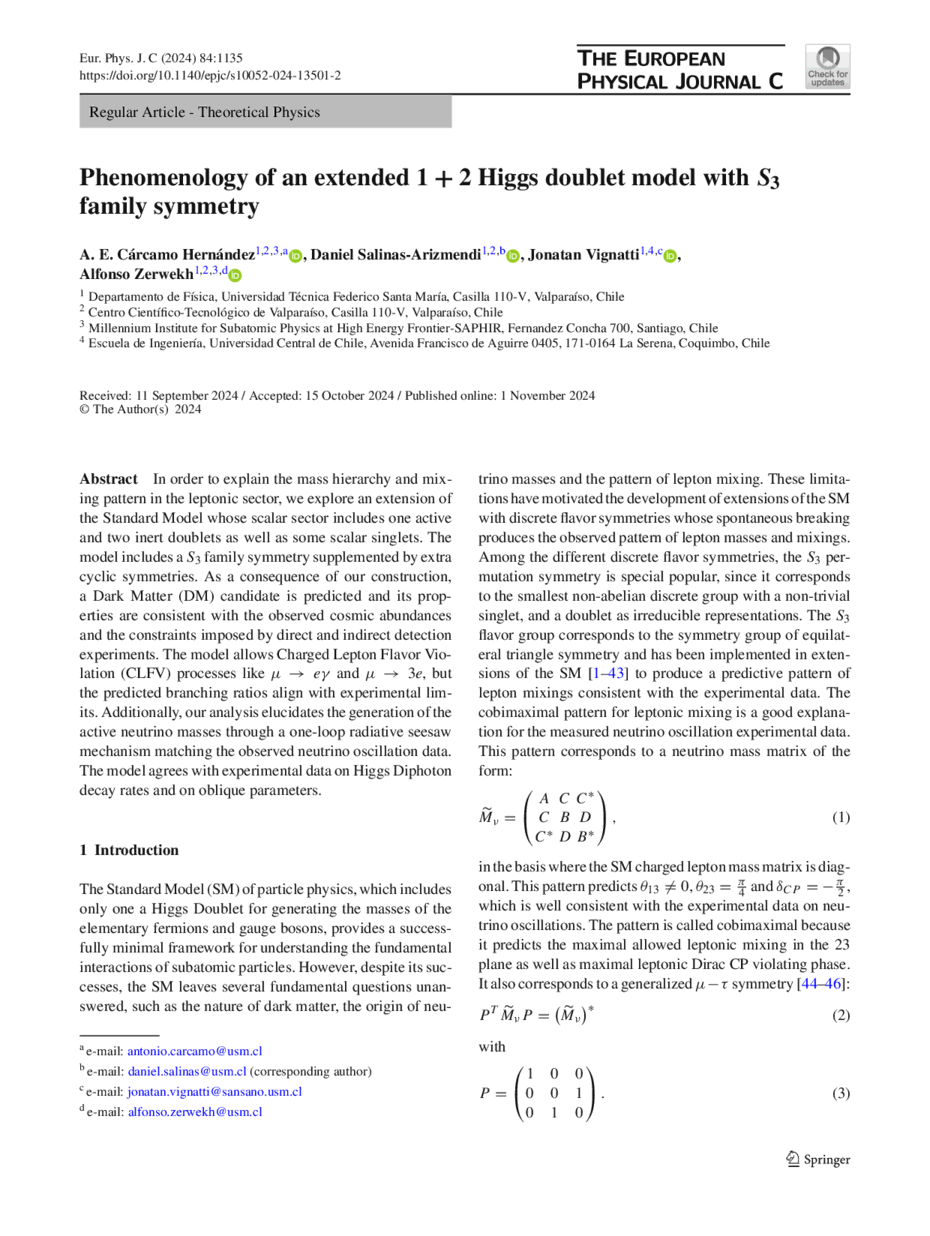https://doi.org/10.1140/epjc/s10052-024-13501-2
Regular Article - Theoretical Physics
Phenomenology of an extended  Higgs doublet model with
Higgs doublet model with  family symmetry
family symmetry
1
Departamento de Física, Universidad Técnica Federico Santa María, Casilla 110-V, Valparaíso, Chile
2
Centro Científico-Tecnológico de Valparaíso, Casilla 110-V, Valparaíso, Chile
3
Millennium Institute for Subatomic Physics at High Energy Frontier-SAPHIR, Fernandez Concha 700, Santiago, Chile
4
Escuela de Ingeniería, Universidad Central de Chile, Avenida Francisco de Aguirre 0405, 171-0164, La Serena, Coquimbo, Chile
Received:
11
September
2024
Accepted:
15
October
2024
Published online:
1
November
2024
In order to explain the mass hierarchy and mixing pattern in the leptonic sector, we explore an extension of the Standard Model whose scalar sector includes one active and two inert doublets as well as some scalar singlets. The model includes a  family symmetry supplemented by extra cyclic symmetries. As a consequence of our construction, a Dark Matter (DM) candidate is predicted and its properties are consistent with the observed cosmic abundances and the constraints imposed by direct and indirect detection experiments. The model allows Charged Lepton Flavor Violation (CLFV) processes like
family symmetry supplemented by extra cyclic symmetries. As a consequence of our construction, a Dark Matter (DM) candidate is predicted and its properties are consistent with the observed cosmic abundances and the constraints imposed by direct and indirect detection experiments. The model allows Charged Lepton Flavor Violation (CLFV) processes like  and
and  , but the predicted branching ratios align with experimental limits. Additionally, our analysis elucidates the generation of the active neutrino masses through a one-loop radiative seesaw mechanism matching the observed neutrino oscillation data. The model agrees with experimental data on Higgs Diphoton decay rates and on oblique parameters.
, but the predicted branching ratios align with experimental limits. Additionally, our analysis elucidates the generation of the active neutrino masses through a one-loop radiative seesaw mechanism matching the observed neutrino oscillation data. The model agrees with experimental data on Higgs Diphoton decay rates and on oblique parameters.
© The Author(s) 2024
 Open Access This article is licensed under a Creative Commons Attribution 4.0 International License, which permits use, sharing, adaptation, distribution and reproduction in any medium or format, as long as you give appropriate credit to the original author(s) and the source, provide a link to the Creative Commons licence, and indicate if changes were made. The images or other third party material in this article are included in the article’s Creative Commons licence, unless indicated otherwise in a credit line to the material. If material is not included in the article’s Creative Commons licence and your intended use is not permitted by statutory regulation or exceeds the permitted use, you will need to obtain permission directly from the copyright holder. To view a copy of this licence, visit http://creativecommons.org/licenses/by/4.0/.
Open Access This article is licensed under a Creative Commons Attribution 4.0 International License, which permits use, sharing, adaptation, distribution and reproduction in any medium or format, as long as you give appropriate credit to the original author(s) and the source, provide a link to the Creative Commons licence, and indicate if changes were made. The images or other third party material in this article are included in the article’s Creative Commons licence, unless indicated otherwise in a credit line to the material. If material is not included in the article’s Creative Commons licence and your intended use is not permitted by statutory regulation or exceeds the permitted use, you will need to obtain permission directly from the copyright holder. To view a copy of this licence, visit http://creativecommons.org/licenses/by/4.0/.
Funded by SCOAP3.





